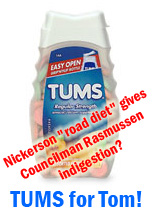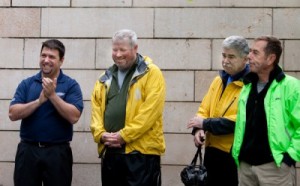[UPDATE: In a comment posted on Cascade Bicycle Club’s blog, Rasmussen says he has “not come out in opposition” to the Nickerson road diet. This still leaves open the possible he may choose to do so, but for now he characterizes himself as in feedback-gathering mode.]
At the recent Bike to Work Day rally in front of City Hall, Seattle City Council member Tom Rasmussen was a featured speaker on the joys of cycling in Seattle.
Rasmussen, who serves on the Council’s bicycle caucus, is a bike commuter and known as a cycling supporter. Who better to rally the troops on the biggest bike day of the year than the chair of the Council’s Transportation Committee?
 So why, then, did Rasmussen subsequently show up in a Seattle Times article complaining of “indigestion” over a proposed “road diet” for Nickerson? Why did he suggest he might support waiting till 2016, which seems like a long way off for a modest and affordable project?
So why, then, did Rasmussen subsequently show up in a Seattle Times article complaining of “indigestion” over a proposed “road diet” for Nickerson? Why did he suggest he might support waiting till 2016, which seems like a long way off for a modest and affordable project?
Why oppose a road diet at all, when a just-released SeattleStoneWayTrafficComparison indicates that a similar project on Stone Way N., another crucial bike-commuter route, showed fewer accidents, more bike trips, and traffic volumes comparable to pre-diet levels? (Translation: no discernible negative impacts on commerce.)
Why, in short, was a cycling proponent taking such an anti-cycling position?
Interpreting Rasmussen’s position requires a bit of decoding. What he told Publicola is that he has heard from both Democratic and Republican 36th district representatives on the Nickerson proposal. Ordinarily that might mean a broad-based bipartisan position, but in this case it simply refers to business interests which still harbor 20th Century misconceptions that bike and pedestrian improvements get in the way of commerce.
The constituency Rasmussen did not mention having heard from was the bike community. In Nickerson, cyclists have a golden opportunity to make their case for improved cycling access and safety — something they talk about all the time. But they had yet to make an impression on Rasmussen.

Most notable in this regard is Richard Conlin, who came from a strong sustainability background, was the city’s biggest bike-boosting official before McGinn, and still promotes green, progressive policies like making Seattle the nation’s first Gross National Happiness city. As his Seattle.gov Web site puts it, “My goal as a Councilmember is to work with you and for you to strengthen neighborhoods, foster economic recovery from the current crisis, and make Seattle a leader in sustainability by envisioning, creating, and implementing new and innovative solutions.”
After playing a prominent role in last year’s Bike to Work Day, Conlin was noticeably missing this year — vacationing in Greece. Given his quarreling with the mayor over the Deep Bore Tunnel, though, it’s probably just as well he was out of town.
Longtime supporters of Conlin and Seattle’s sustainability community are scratching their heads at the standoff between the Council president and the mayor. One problem is that Conlin has not chosen — yet, anyway — to reconcile apparent inconsistencies between his long-held philosophies — “making Seattle a more sustainable city, reducing waste, strengthening neighborhoods, improving pedestrian mobility and transportation infrastructure, and making government more transparent,” as his Web page puts it — and his recently adopted positions.
Rasmussen as well traced his concerns to the viaduct. As he told Publicola, he’s concerned that vehicular traffic will face a hard time of it during the viaduct replacement if Nickerson has to “diet.”
For cyclists, the complex nature of City Hall politicking presents both challenges and opportunities.
With thousands of cyclists commuting on its streets every day, and a No. 4 ranking among the most bike-friendly cities in the nation, Seattle is a recognized cycling hotbed. Besides McGinn, Rasmussen and Conlin, numerous other elected officials support bike agendas. Perhaps the cycling community, then, can be forgiven for assuming its leaders will automatically embrace bike initiatives. In this light, Rasmussen’s stance can be viewed as testing the mettle of the cycling lobby.
To its credit, Cascade Bicycle Club, the nation’s largest, is rolling into action. In response to Rasmussen’s equivocation, club advocacy director David Hiller posted a piece on the Cascade site’s blog that skillfully deconstructs erroneous claims opposing the road diet. Cascade has suggested cyclists send “Tums to Tom” to settle his stomach.
The blog SeattleLikesBikes and supporters have launched Google and Facebook groups as well as a Twitter feed in support of the Nickerson plan.
To fully persuade Rasmussen, though, cyclists will need to get their voices heard in less receptive quarters, including the constituencies that Rasmussen said were making him ill.
Seattle is facing a wrenching transition from expensive, conventional car-dominated agendas to new, localized, sustainable, “green” and forward-looking policies. It’s a battle between Fading Seattle and Emerging Seattle — Old Seattle vs. New Seattle.
The former jumps into action any time a cycling initiative threatens to impact truck and commercial traffic — Ballard’s “Missing Link,” Stone Way’s bike lanes, the Nickerson road diet. It doesn’t matter that bike and pedestrian improvements (they typically go hand in glove) consistently improve commerce in communities where they’re adopted by putting more people and patrons on the streets. Nor does it seem to make a difference that small businesses, especially the growing numbers of eco-friendly ones, actually support biking and walking and understand the need for people-first policies. Any time street uses other than cars and trucks are on the agenda, the old guard is going to oppose them.
Representing New Seattle are groups like SCALLOPS — Sustainable Communities All Over Puget Sound — Feet First, Cascade (the nation’s largest bike club), People for Puget Sound, Seattle Transition, the People’s Waterfront Coalition and the newly formed Streets for All Seattle, which signed up more than 50 supporters to help back the mayor’s Walk Bike Ride campaign (BikeIntelligencer is one).
The results of last November’s election, which swept into office streets-friendly candidates from Obama on down to Seattle municipal races, were a clear sign of Seattle’s changing politics — and New Seattle’s growing influence. But Old Seattle, which still has financial clout and the Old Boys Network on its side, is not going to roll over and die.
Cyclists are a key part of New Seattle. To follow through on the agenda they used to get candidates elected, they will have to work the community councils, precinct monthlies and civic and business groups like Chambers of Commerce and Rotaries.
Cascade’s recently formed Bike Business Forum is a step in this direction; the club also is helping generate turnout for a review of the project at Rasmussen’s committee on June 8.
It will take time and elbow grease — and maybe a few bouts of indigestion — to move Seattle from old to new.
But to make their tummies feel better, cyclists only have to use their heads and feet.
More links:
Seattle Times: Road diet gives Rasmussen indigestion.
Seattle Transit Blog: Stone Way Road Diet Improved Safety, City says.
Publicola: Cascade says send Tums to Tom.
Cascade Bicycle Club’s David Hiller: Here we go again.
SeattleLikesBikes: Support the Road Diet!
Paris bike plan moving forward.
San Francisco bike plan may move forward.
